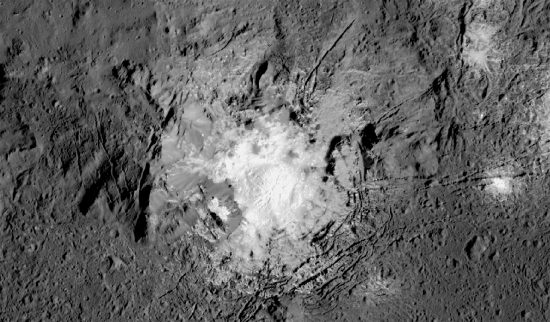
Occator Crater’s central mound. Credit: NASA/JPL-Caltech/UCLA/MPS/DLR/IDA
Aug 1, 2016
Long time passing….
The Dawn mission was launched on September 27, 2007. It first entered orbit around the asteroid Vesta on July 17, 2011, departing on September 5, 2012 toward Ceres. Dawn arrived at Ceres on Friday, March 6, 2015.
According to a recent press release, mission team members presumed that Ceres would be a “…heavily cratered body generally resembling the asteroid Vesta.” However, they were surprised to find that Ceres is lacking in large craters; those bigger than 400 kilometers in diameter are “missing”.
David Williams, who is the director of the Ronald Greeley Center for Planetary Studies in Arizona State University’s School of Earth and Space Exploration, wrote:
“This presents a mystery because Ceres must have been struck by large asteroids many times over its 4.5-billion-year history.”
Simone Marchi of the Southwest Research Institute concluded that “…a significant population of large craters on Ceres has been obliterated beyond recognition over geological time scales, which is likely the result of Ceres’ peculiar composition and internal evolution.”
Despite the presumptions about crater count by the mission team, there are craters on Ceres so large that they are out of proportion to the dwarf planet’s size. There are formations there that are familiar to Electric Universe advocates: rilles and trenches gouged into its surface, strange mountains and hills, as well as bright material just below what looks like a scorched and blasted surface. Other objects in the Solar System exhibit similar characteristics. Vesta appears to be a smaller twin of Ceres, with comparable formations.
A conundrum for planetary scientists is that Ceres resembles other, larger celestial bodies, some that are planetary in scope. Mercury, for example. Common features on Mercury are large craters with fractures and furrows running through them. Previous Pictures of the Day about the MESSENGER probe illustrate Mercury’s electrical scarring. Furrows radiate outward from some craters, marking the paths of untold electric filaments. On Earth, those filaments would have been the largest lightning strikes ever witnessed.
One of the most interesting features on Ceres is the crater, Occator, meaning, “the harrower”. Occator is a large crater, approximately 90 kilometers wide and four kilometers deep. However, what is most intriguing is the large, bright mound and surrounding bright patches inside the crater, as in the image at the top of the page.
Since an electric arc is composed of filaments, it can act like a “plasma drill,” cutting vertical crater sidewalls, while sometimes leaving a “pinched up” mound in the center. Multiple filaments cut one crater within another, often with one or more craters on the rims. Urvara crater on Ceres is steep-walled, with chevron-shaped scars entering the crater in two places. Impact or volcanic eruption cannot create those formations. Gaue crater, on the other hand, is melted with slumped sidewalls—not what a meteor impact can do.
Many Picture of the Day articles point out that, in consensus circles, electricity is not considered to be a formative influence. However, with a better theory, it can be demonstrated that large craters on Ceres are electrical in nature. Their steep sides, sharp rims, flat floors, a lack of blast debris inside the craters or strewn around them, and the rilles that criss-cross their centers are forensic evidence for electric arcs.
When electricity passes over a solid body, charge flow pulls material from the contact surface. Neutral dust and stones are dragged along with ionized particles. Electric arcs make circular craters because electromagnetic forces maintain right angles to the touchdown point. Since two or more filaments rotate around an arc axis, it excavates the aforementioned steep side walls.
On a negatively charged surface, arcs will travel, sometimes eroding elongated craters. Arcs might also jump from high point to high point, forming smaller craters on the rims of larger ones. Crater chains are another sign of arcing to a negatively charged body. Electric arcs change in power from millisecond to millisecond, so they burn the surface unevenly. In fact, “smooth” channels seen on Ceres are crater chains.
June 30, 2016 marked the official end of Dawn’s mission, although NASA approved an extension. Ultimately, Dawn will not land on Ceres as the NEAR-Shoemaker satellite landed on Eros. It will not be crashed into the surface like MESSENGER or be incinerated in an atmosphere like Galileo—especially as there is no atmosphere at Ceres. Dawn will continue circling Ceres indefinitely (a minimum of fifty years), since its orbit is stable.
Ceres presents another in a long list of electrically devastated worlds.
Stephen Smith
With apologies to Pete Seeger












